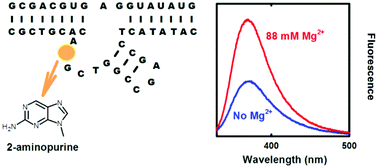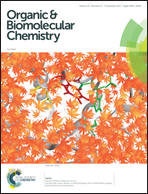Local conformational changes in the 8–17 deoxyribozyme core induced by activating and inactivating divalent metal ions†
Abstract
The 8–17 deoxyribozyme (DNAzyme) is a catalytic DNA molecule capable of cleaving specific RNA substrates. The deoxyribozyme is activated by a wide variety of divalent metal ions, from Mg2+ to Pb2+, with just a few exceptions. It is not clear if metal ions are directly involved in catalysis, or are required to attain an active conformation, or both. In particular, the connection between metal-induced global structural rearrangements and catalysis is not straightforward. To gain more information on the local structural changes induced by metal ions, we introduced fluorescent 2-aminopurine (2-Ap) residues at different positions of the 8–17 ‘core’. We found that a construct containing 2-Ap at position 15 was best suited to monitor conformational changes in the presence of Mg2+, Ca2+ or Mn2+. Binding of these activating metal ions caused a local rearrangement at position 15, apparently entailing decreased stacking of the 2-Ap base. The metal dependence for such conformational change was generally hyperbolic (suggesting it mirrored the binding by a single metal ion) and yielded apparent dissociation constants close to those required for activation. In contrast, Cu2+, a divalent metal ion which does not support catalysis, caused in the deoxyribozyme a slow, reversible inactivation, which correlated with a very distinct conformational change at position 15.



 Please wait while we load your content...
Please wait while we load your content...